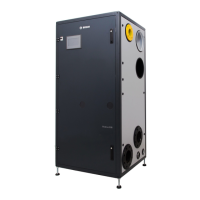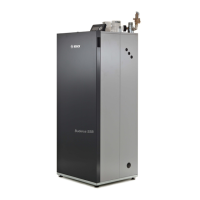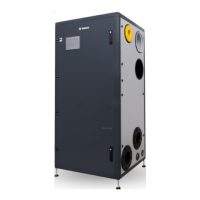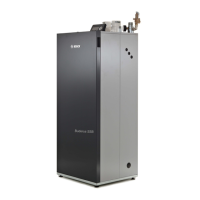SSB 6720866942 (2018/06) US
Commissioning | 31
5 Commissioning
5.1 Introduction
Before starting the boiler, the user must be correctly instructed by the
installer, on how to operate the heater, in particular:
• Make sure that the user understands that combustion air and
ventilation openings must not be restricted, closed, or modied in any
way.
• Make sure that the user is informed of all the special measures to be
taken for combustion air inlet and discharging ue gases, and that
these must not be modied in any way.
• Make sure that the user keeps this manual and all other
documentation included with the boiler.
• Make sure that the user understands never to tamper with gas
control settings and the risk of CO poisoning should an unauthorized
individual do so.
• Make sure that the user knows how to adjust temperatures and
controls.
WARNING: Do not attempt to dry re the unit. Starting the
unit without a full water level can seriously damage the unit
and may result in injury to personnel or property damage.
This situation will void any warranty.
CAUTION: All of the installation procedures in “Installation”
page 11 must be completed before attempting to start
the unit.
5.2 Filling the condensate system
The condensate system must be lled with water according to the Section
“Pressure relief valve installation” page 16.
WARNING: At the Start-up and after prolonged shutdown of
the boiler, the condensate traps and the syphon must lled
with water prior to restart it, otherwise combustion gases will
enter the room with a risk of an excessive level of carbon
monoxide.
5.3 Filling the boiler heating system
To ll the heating system, proceed as follows:
• Open any automatic air vents in the heating system.
• Open the ll valve and proceed to ll the heating system and boiler
until the pressure gauge (shown on Fig. 48), reads the pressure for
which the heating system is sized. The heating system water pressure
must be higher than 7.5 PSI.
• Check that there is no water leaking from the ttings. If there is, the
leaks must be repaired.
• Close all water shutoff valves in the boiler.
• Open return valve in system header to allow the water to ll the return
header in the boiler.
• Starting at one module, open the return shutoff valve allowing the
water to ll the pump and heat exchanger. The automatic vent valve
should start to release the air from the heat exchanger.
• Once air has stopped, open the supply valve on the outlet of the heat
exchanger allowing the water to ll the supply header in the boiler.
• Move up to the next module and repeat this process.
• Once both modules have been done, open the supply valve on the
system header.
• Check the pressure gauge during the purging process. If the pressure
has dropped, re-open the ll valve to bring the pressure back to the
desired value.
The combustion air must be free of:
• Permanent wave solutions;
• Chlorinated waxes/cleaners;
• Chlorine-based swimming pool chemicals;
• Calcium chloride
• Sodium chloride used for water softening;
• Refrigerant leaks;
• Paint or varnish removers;
• Hydrochloric acid/muriatic acid;
• Cements and glues;
• Antistatic fabric softeners used in clothes dryers;
• Chlorine-type bleaches, detergents, and cleaning solvents found in
household laundry rooms;
• Adhesives used to fasten building products and other similar products.
To prevent contamination do not connect the combustion air inlet and
exhaust near:
• Dry cleaning/laundry areas and establishments;
• Swimming pools;
• Metal fabrication plants;
• Beauty shops;
• Refrigeration repair shops;
• Photo processing plants;
• Auto body shops;
• Plastic manufacturing plants;
• Furniture renishing areas and establishments;
• Remodeling areas;
• Garages with workshops
Whenever the environment contains these types of chemicals, combustion
air MUST be supplied from a clean area outdoors for the protection and
longevity of the equipment and warranty validation.
The more common methods of combustion air supply are outlined in the
following sections.
4.8.1 Ducted combustion air
For ducted combustion air installations, the air ductwork must then be attached
directly to the air inlet connection on the sheet metal enclosure.
When combustion air is taken through the roof, a eld-supplied rain cap or an
elbow arrangement must be used to prevent entry of rain water.
The ducts must be routed to the boiler as directly as possible, with all joints
sealed, and supported by adequate hangers.
In a ducted combustion air application, the combustion air ducting pressure
losses must be taken into account when calculating the total maximum allowable
venting run (see table on page “Venting Congurations: The following gures
show the acceptable piping installation for venting and combustion air for both,
Stand Alone and Cascade congurations.” page 26).
For additional details, see
“Appendix F - Exhaust terminals and Air inlet
Clearances”.

